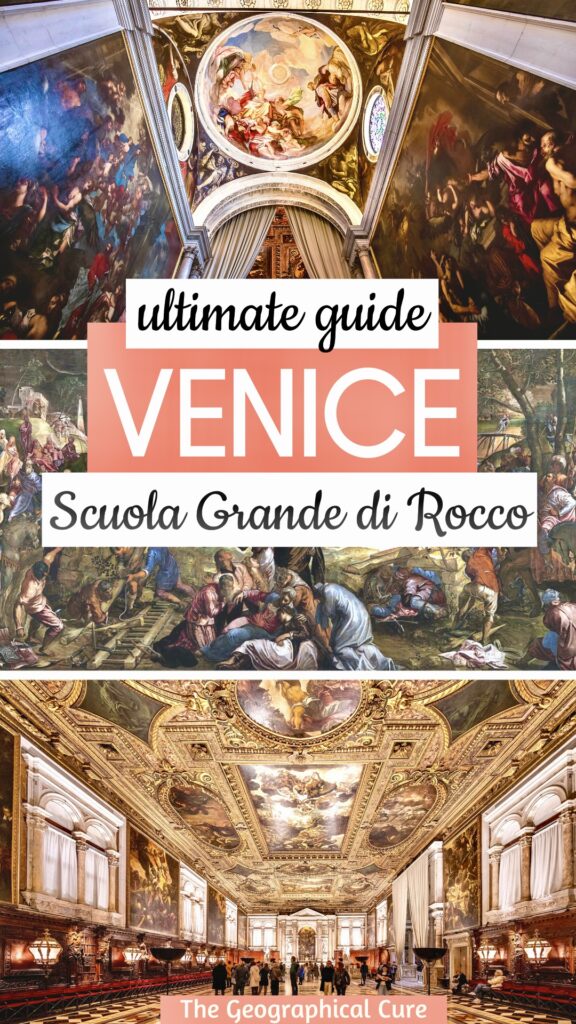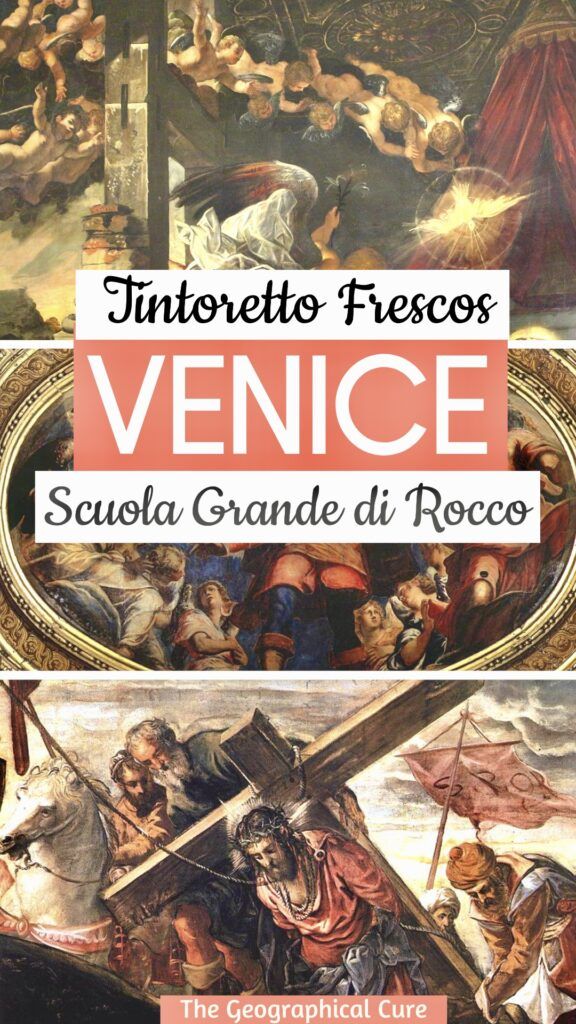Exploring Venice? Don’t miss the Scuola Grande di San Rocco in the San Polo neighborhood. This guide gives you an overview of the complex and its must-see masterpieces.
The scuola is one of Italy’s most beautiful decorated complexes. It served as the prestigious headquarters of the Brotherhood of San Rocco.
The famed Renaissance artist Tintoretto decorated almost every inch of the interior.
His monumental fresco cycle in the Chapter Hall is often referred to as “Sistine Chapel of Venice.” And, like the Sistine Chapel, the works can only be admired onsite in the room for which they were made.
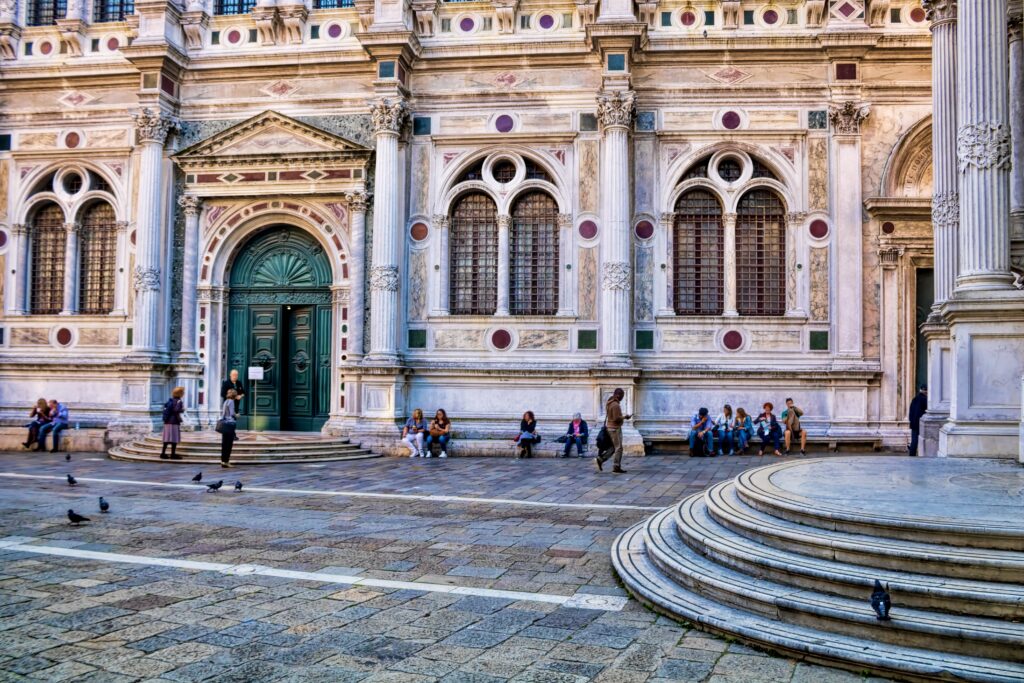
You’ll be amazed by the sheer abundance of canvases that adorn the walls. Thankfully, portable handheld mirrors are provided. They allow you to appreciate the ceiling paintings without straining your neck.
>>> Click here to book a walking tour of San Polo and Dorsoduro
Short History Of The Scuola
In the 13th century, Venice experienced a fascinating development – the emergence of the “scuole” or schools. These were like exclusive clubs created by wealthy Venetians.
Their focus? Philanthropic deeds to help the poor and finding ways to make amends to save their own souls.
The scuole were also major patrons of the arts and architecture, hiring renowned artists and architects to craft incredible works.
Among these scuole, one group stood out – the Brotherhood of St. Roch. Established in 1478, they were the crème de la crème, made up of high-ranking members from the merchant and professional classes.
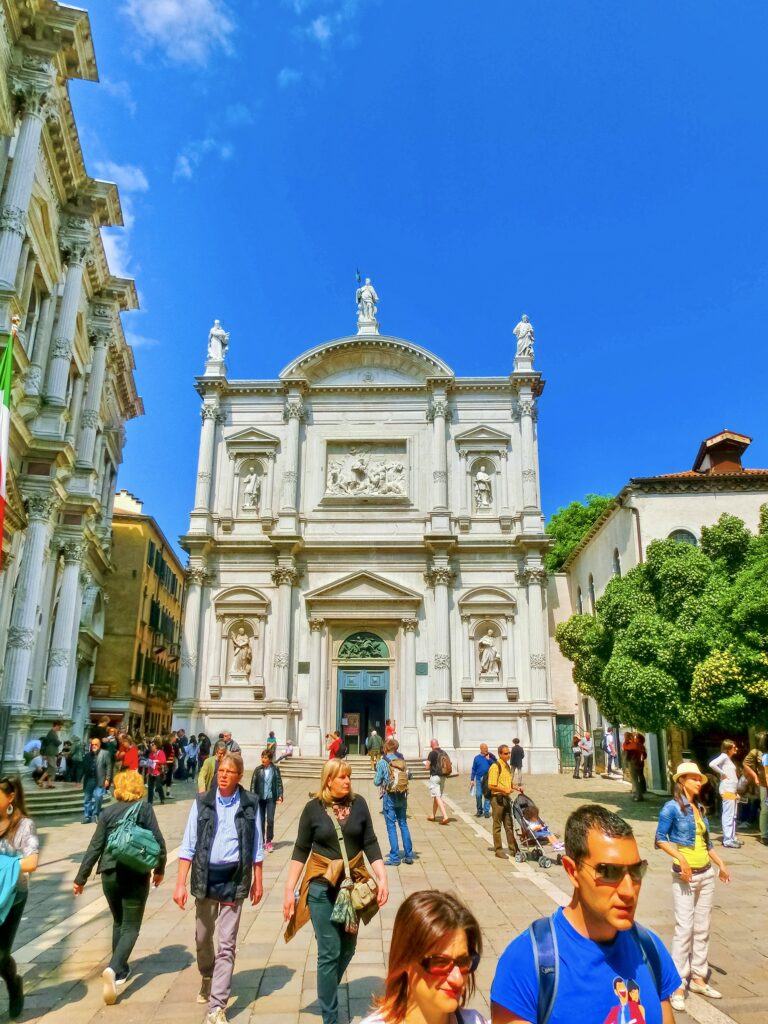
Their devotion centered around St. Roch, a revered patron saint of Venice. He was known for his miraculous protection against plagues and his affinity for dogs.
In the 16th century, the brotherhood found a permanent residence designed by architect Bartolomeo Bon in the San Polo district of Venice. Like most grand scuola, it was comprised of:
- great hall for public meetings on the ground floor;
- a grand staircase
- the Chapter Room on the floor above exclusively for members of the scuola; and
- a room room set off the Chapter Hall known as the Albergo, which was the board room reserved for the members of the high council and the guardian (leader) of the scuola.
The Albergo was where all the decision were made. It became customary to decorate it with narrative scenes.
While the building’s exterior might not be overly impressive, its interior decoration is truly remarkable.
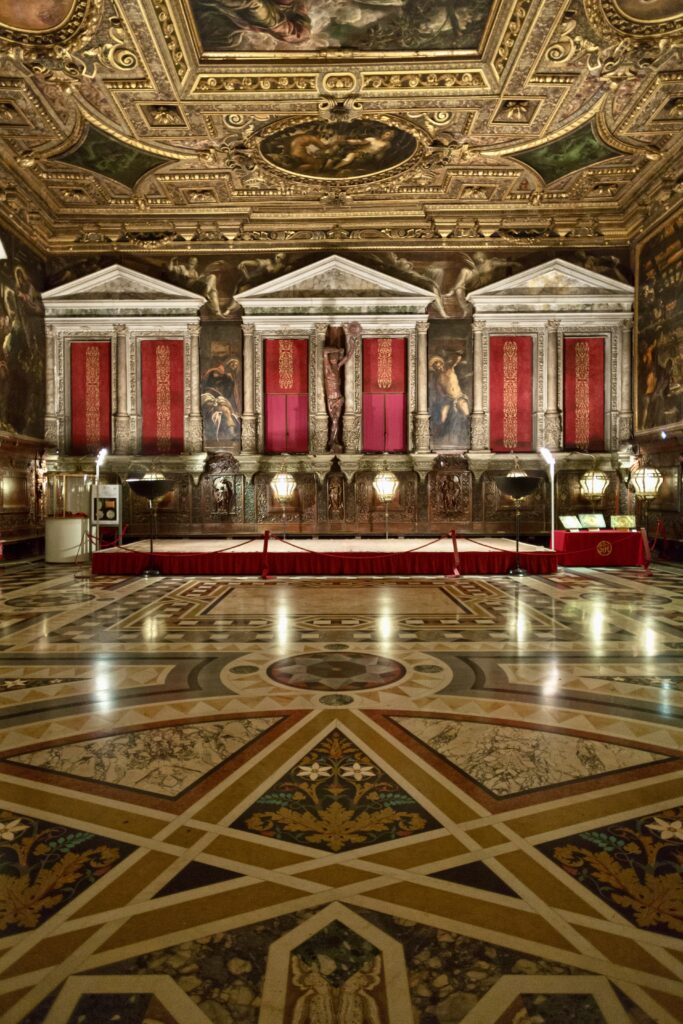
It’s peak Renaissance. Every nook and cranny of this place is adorned with intricate details.
The floors are a mosaic of polished stones in geometric patterns. Elaborate carvings and gilded moldings adorn every corner. And the wrought-iron lamps are as large as a person.
In 1564, the scuola held a competition to embellish the interior of the Albergo. Tintoretto’s approach to winning this competition was unconventional. Perhaps it even amounted to chicanery.
Instead of submitting a customary paper modello, a wily Tintoretto secretly toiled overnight. He produced a life-sized painting of St. Roch and and installed it on the ceiling for all to see.
His audacious move captivated the judges. They awarded Tintoretto the win over competitors like Salviati, Zuccari, and Veronese.
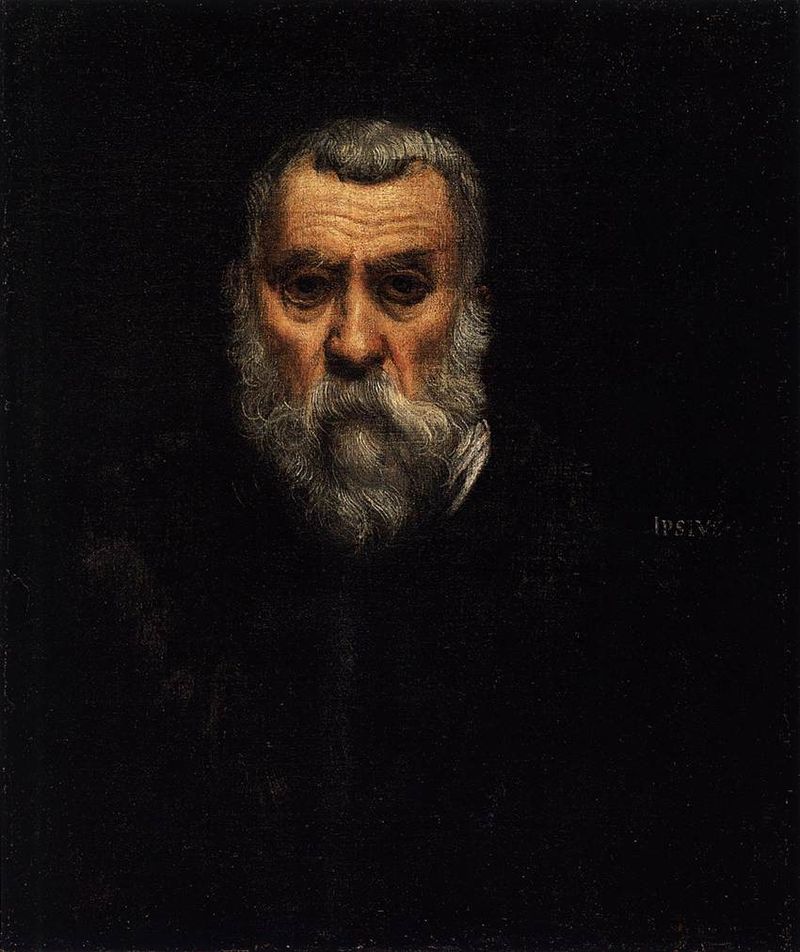
Who Was Tintoretto? A Short Biography
So who was the artist responsible for all this great art?
Tintoretto is one of the most dynamic and innovative figures in Venetian Renaissance art. His artistry was marked by a relentless desire to experiment and push the boundaries of traditional Renaissance techniques.
Born in 1518, Tintoretto’s actually family surname was Robusti. But he adopted the name Tintoretto due to his father’s occupation as a dyer (tintore in Italian).
Tintoretto was influenced by his rivals and renowned artists of the time like Titian and Michelangelo. He famously said, “The first painter was Titian, the second Michelangelo, and the third Tintoretto.”
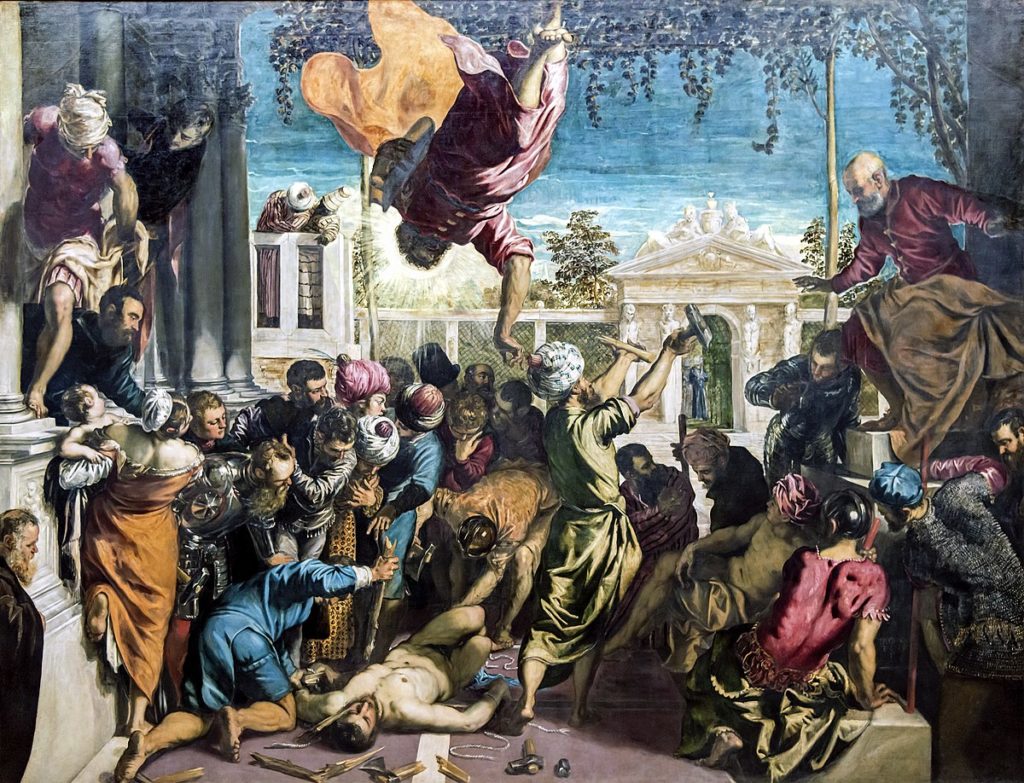
But he carved out his own path and gave his work a thunderous power.
His distinctive style is characterized by the dramatic and moody use of light and shadow and intense emotional narratives. The chiaroscuro would go on to influence the great Baroque artist Caravaggio.
Tintoretto also used unconventional perspectives that gave his paintings an almost cinematic quality. Sometimes his high wire scenes seem to defy gravity itself. And they almost dare you to look away.
Tintoretto’s brushwork was rapid and energetic, resulting in a sense of movement and depth in his compositions. In fact, the artist was given the moniker Il Furioso (the furious) because of his fast and furious painting style.
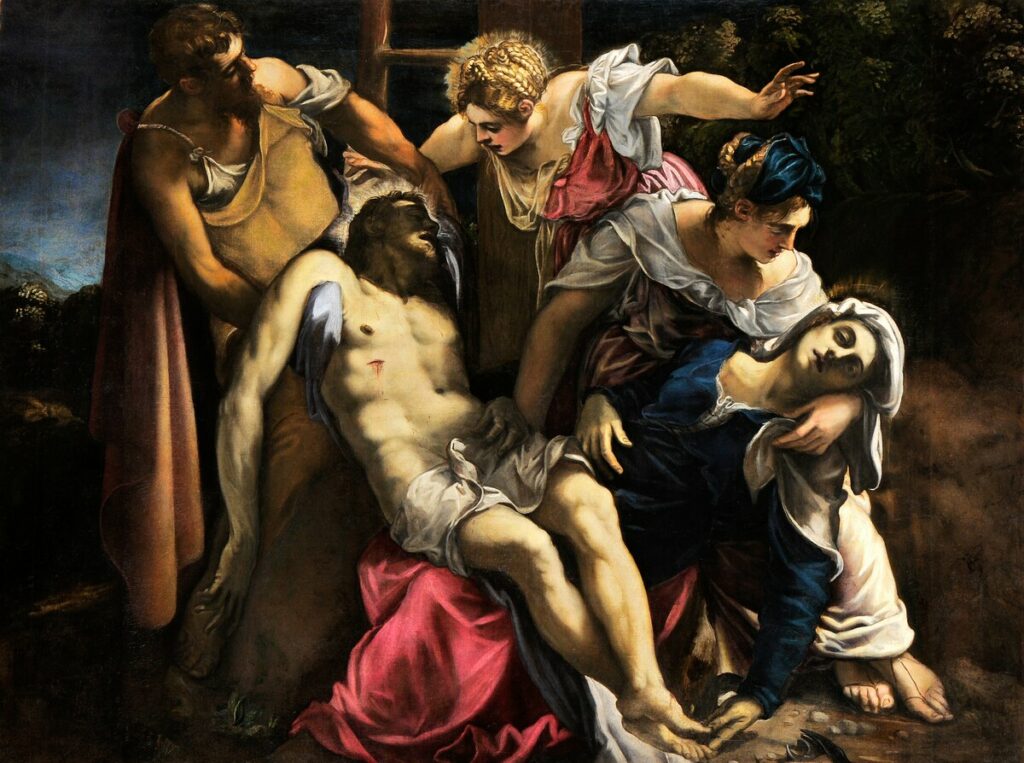
Tintoretto spent the last two decades of his life slaving away on the fresco cycles in the Scuola Grande di San Rocco. On and off for 23 years, he continued adding an overwhelming array of biblical scenes. In total, there are 65 Tintoretto paintings in the scuola.
It was to be his epic masterpiece. Indeed, these are some of the best and boldest paintings of the Italian Renaissance.
Part of their impact is the sheer scale — the repetitive iteration of one man’s style and vision over a vast series of spaces. Part of it is their blockbuster style and effect.
Tintoretto is somewhat less renowned than other Venetian painters like Titian. But that’s because almost all of his work is in Venice, and much of it is in situ and can’t be moved. Tintoretto was a homebody who never really left his aquatic hometown for other commissions.
>>> Click here to book a private art tour of Venice that includes the scuola
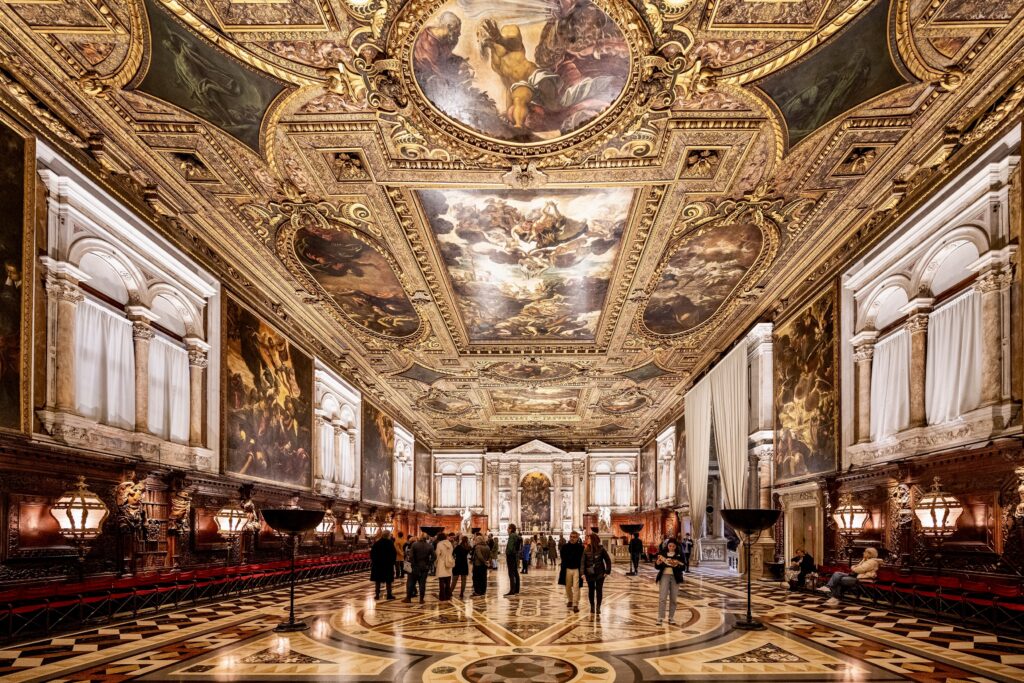
Guide To The Scuola Grande di San Rocco: What To See
When you enter, pick up a free explanatory leaflet and audio guide. You’ll get a primer on the individual paintings and can follow the development of Tintoretto’s style.
It’s best to begin upstairs in the Sala dell’Albergo. Here are the some of the must-see highlights in the scuola. Aside from Tintoretto, there are some lovely pieces by Titian, Giorgione, and Tiepolo.
1. Tintoretto Paintings In The Albergo
The paintings in the Albergo represent scenes from the Passion of Christ. They are some of the most powerful and theatrical paintings of the Renaissance.
If you are standing in the Abergo, turn your back on the large Crucifixion and turn your gaze to the painting above the entrance, the Ecco Homo.
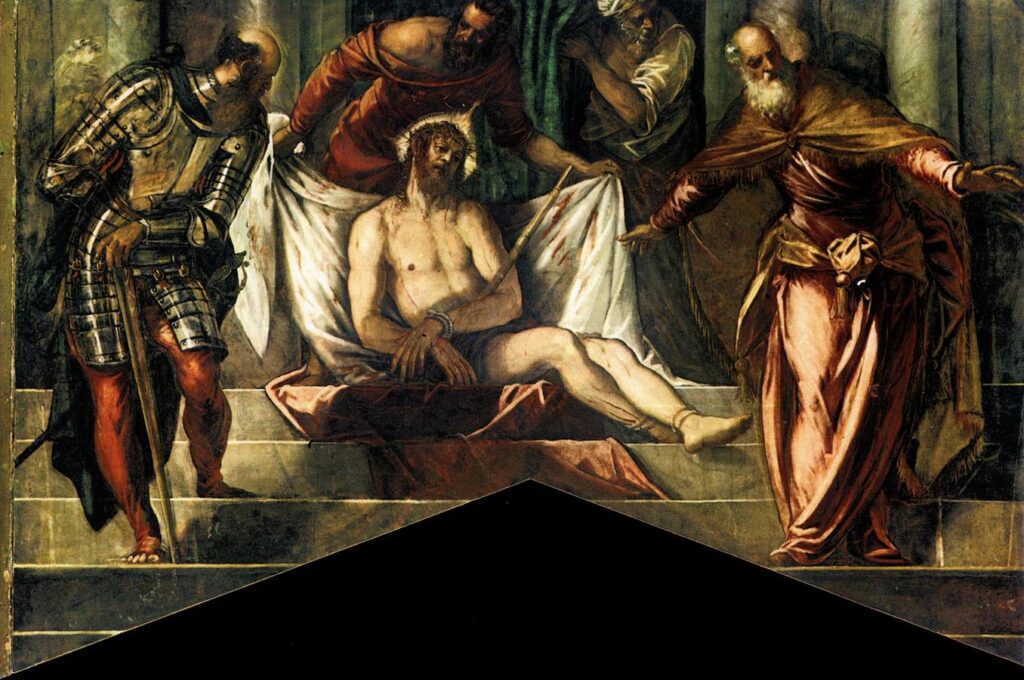
Ecco Homo
This painting depicts the episode from the passion where Pontius Pilate thought that if he had Christ beaten, that act would placate the blood lust for his life.
Pilate shows him to the crowd in this bruised and battered state. Christ lies on the stairs. Blood runs over his body. The crown of thorns is visible through halo above his head.
Pilate gestures dramatically on the right. On the left, is the sinister man in armor who inflicted the damage on Christ. He has an off-putting smug look.
As we know, the beating wasn’t enough. The crowd wanted him crucified.
Pilate Washing His Hands
The next painting in the narrative order is to the right. It’s a vertical painting. The figure is turned at an odd angle.
Christ is redressed in a white robe, standing there like a sacrificial lamb. Pilate is in an alcove washing his hands. This symbolizes Christ’s death sentence.
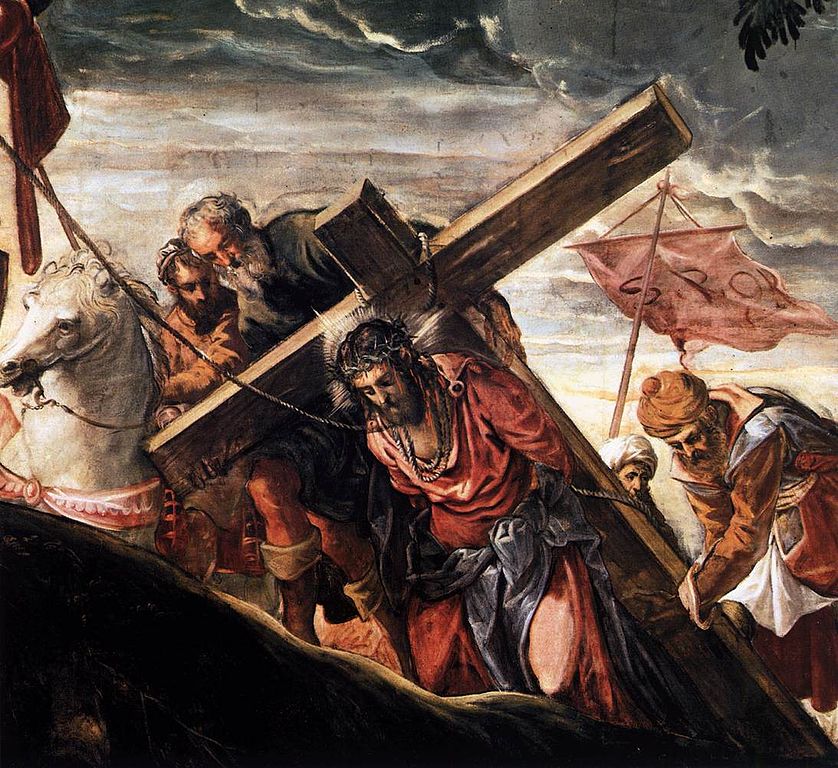
Christ Carrying the Cross
The next scene in the narrative is Christ Carrying the Cross. It’s also called the Road to Calvary. It depicts the moment from the passion when Jesus carries the cross to the site of his crucifixion.
The figures in the painting are rendered with striking realism and a profound sense of humanity. Tintoretto wanted to evoke empathy and connection from the viewer.
In the painting, Jesus’s expression and posture convey both physical strain and spiritual weight. Again, the figures are arranged diagonally. You can see a flag with the letters SPQR, indicating the Roman Empire.
It’s a non-traditional composition. There’s a dark base and then light filtering through the top in classic Tintoretto fashion.
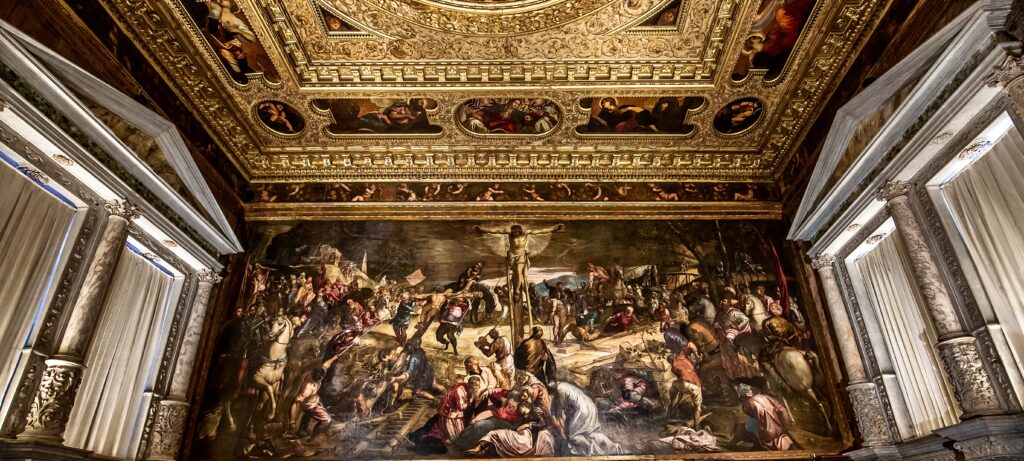
Crucifixion
Tintoretto’s colossal Crucifixion is the most famous painting in the scuola and one of the most significant religious artworks of the century. Artist John Ruskin described it as “beyond all analysis and above all praise.”
It’s massive, covering the entire wall behind the altar. It’s 17 feet tall and 40 feet across.
The scene is epic in all senses of the word. (To some, it may appear overwrought by 21st century standards.)
It’s a frenetic scene with numerous figures. Some faces are turned towards Christ. Others go about their business.
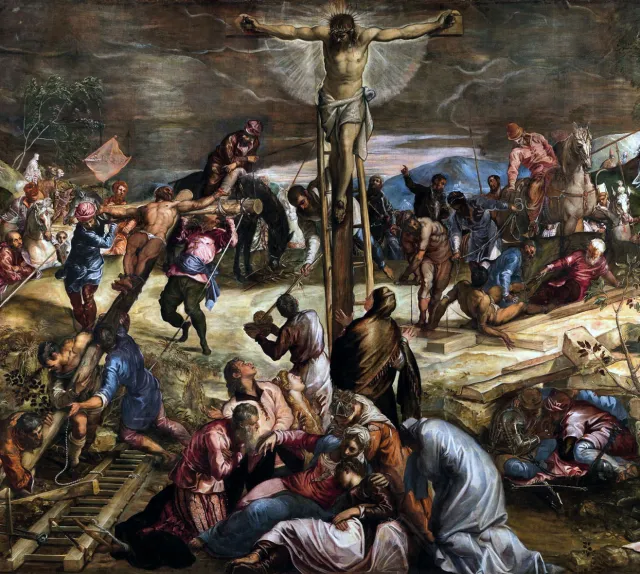
Christ is show in agony on the cross, while mourners and soldiers look on from below. You can identify Mary Magdalene by her strawberry blond hair. The Virgin Mary is shown reclining, as if she’s lost consciousness.
Tintoretto masterfully arranges his figures into purposeful clusters and employs a network of diagonals that converge on the central figure of Christ on the cross.
A radiant triangle of light-colored terrain emerges, its lower point resting at the base of the cross. As you pivot, another triangle of similar size and luminosity enters the view – the white pediment of intricately carved stone positioned above the entrance door.
The scene is rendered in Tintoretto’s signature dramatic style, with exaggerated perspectives, bold brushstrokes, and strong contrasts of light and dark.
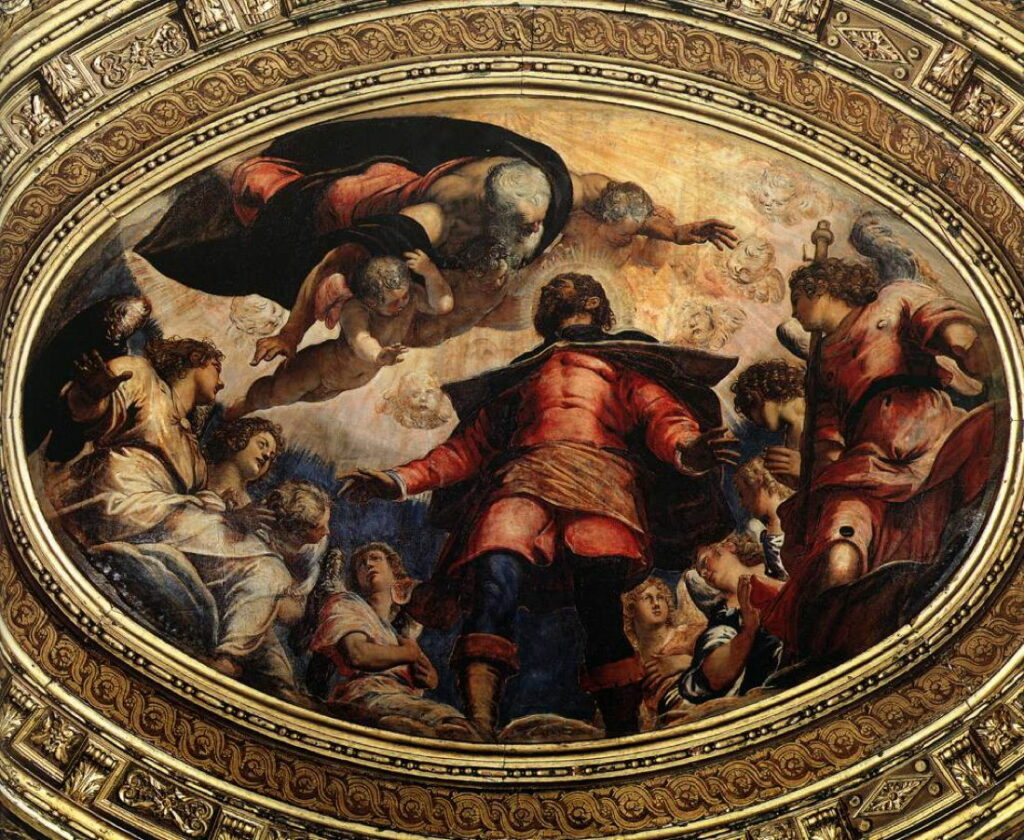
Glorification of St. Roch
This is the painting that won Tintoretto the competition. It’s the central ceiling panel.
This painting tells the story of St. Roch, a revered figure known for his selfless devotion to helping those suffering from the plague. The painting captures the moment of St. Roch’s ascent to heaven, surrounded by angels and bathed in divine light.
The composition radiates a sense of spiritual elevation and profound reverence. With his dynamic brushwork and mastery of light, Tintoretto infuses the scene with a sense of celestial grandeur.
The figure of St. Roch is brilliantly foreshortened. His humble and compassionate nature is beautifully portrayed, making the viewer feel his journey from earthly to divine realms.
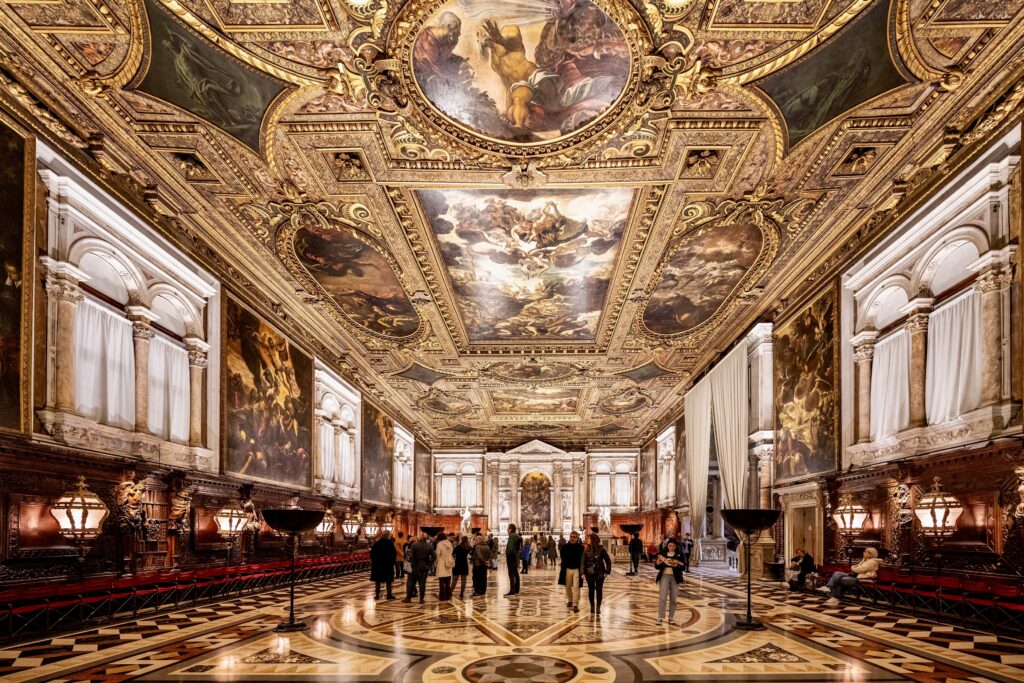
2. Tintoretto Paintings In The Chapter Hall
This grand hall, called the Sala Capitolare, was the next phase of Tintoretto’s decorative scheme. Walk through the door from the Albergo and into the large rectangular hall.
The room consists of 33 paintings that make the Chapter Hall the most spectacular part of the decorative complex. The ones on the ceiling are from the Old Testament. The ones arranged around the side walls are from the New Testament and the life of Christ.
The themes are related to the scuola’s mission — to help the poor and downtrodden and to save their own souls along the way.
These are some of Tintoretto’s best works. They are generally considered a master class on perspective, shadow, and color.
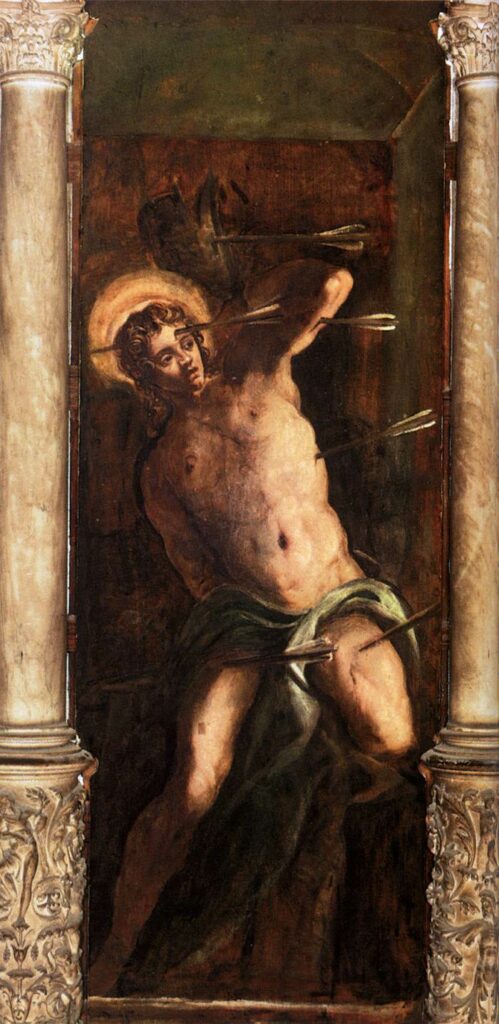
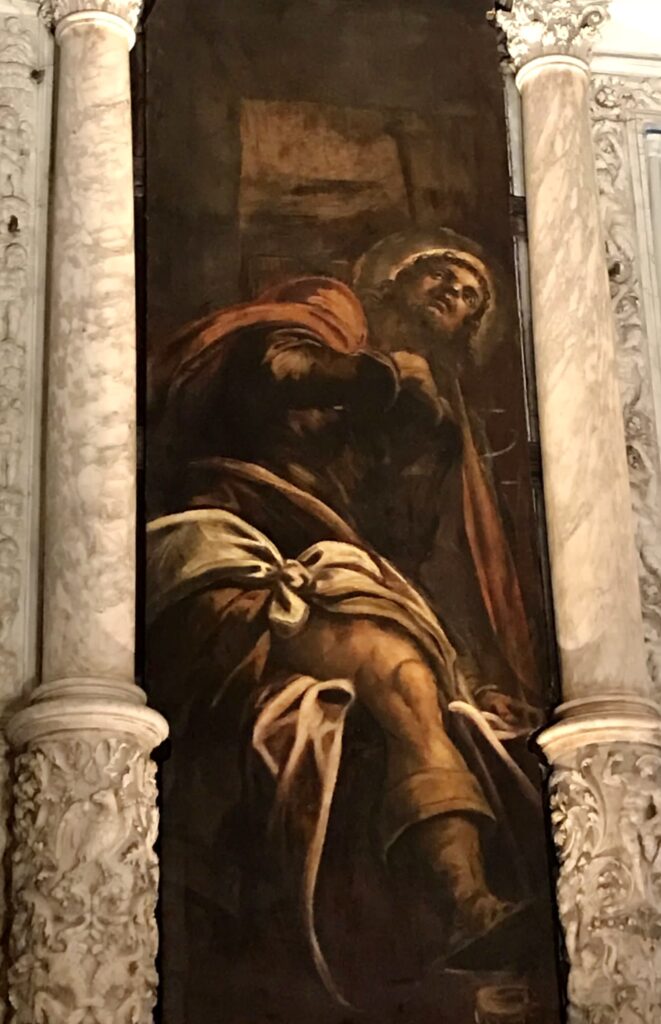
St. Roch and St. Sebastian
You first see two tall, thin vertical paintings on the left between the windows, of St. Roch (left) and St. Sebastian (right)
St. Sebastian is another Christian martyr (like St. Roch). He’s often depicted as a young man tied to a tree or post and shot with arrows. Yet, he somehow manages not to die.
You’ll notice a rather strange detail in Tintoretto’s depiction though. Not only are there the usual arrows piercing his body. There is also an arrow going through his forehead.
This isn’t a common feature in depiction of the saint. It might have been Tintoretto’s attempt to add a touch of humor to the otherwise weighty religious scenes.
St. Roch is dressed in his traditional garb and holds his walking stick. You’ll see a blemish on his left leg, a scar left from the plague. Very unusually, he’s not shown with his dog.
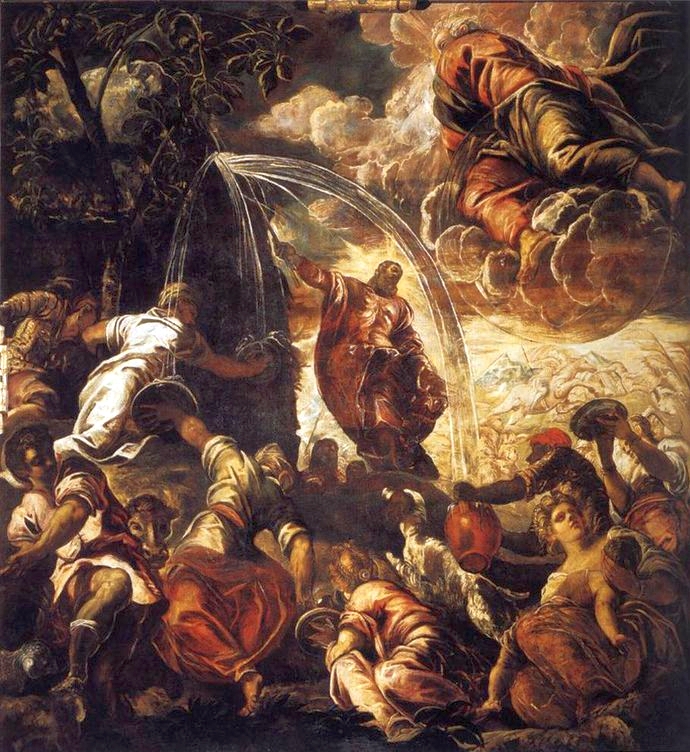
Moses Striking Water From The Rock
The central ceiling panel is the largest painting in the Chapter Hall. It depicts the Old Testament story of Moses striking water from a rock to give drink to the thirsty.
Tintoretto’s interpretation of this scene is nothing less than spectacular. You have a dramatic worm’s eye perspective.
Moses, dressed in red, occupies the middle ground. He strikes the stone with his magic rod. God is placed above on a cloud, suggesting his divine intervention.
The overall appearance of the painting is pretty dark. This is because the artist primed many of his paintings in a dark color before he even began to paint.
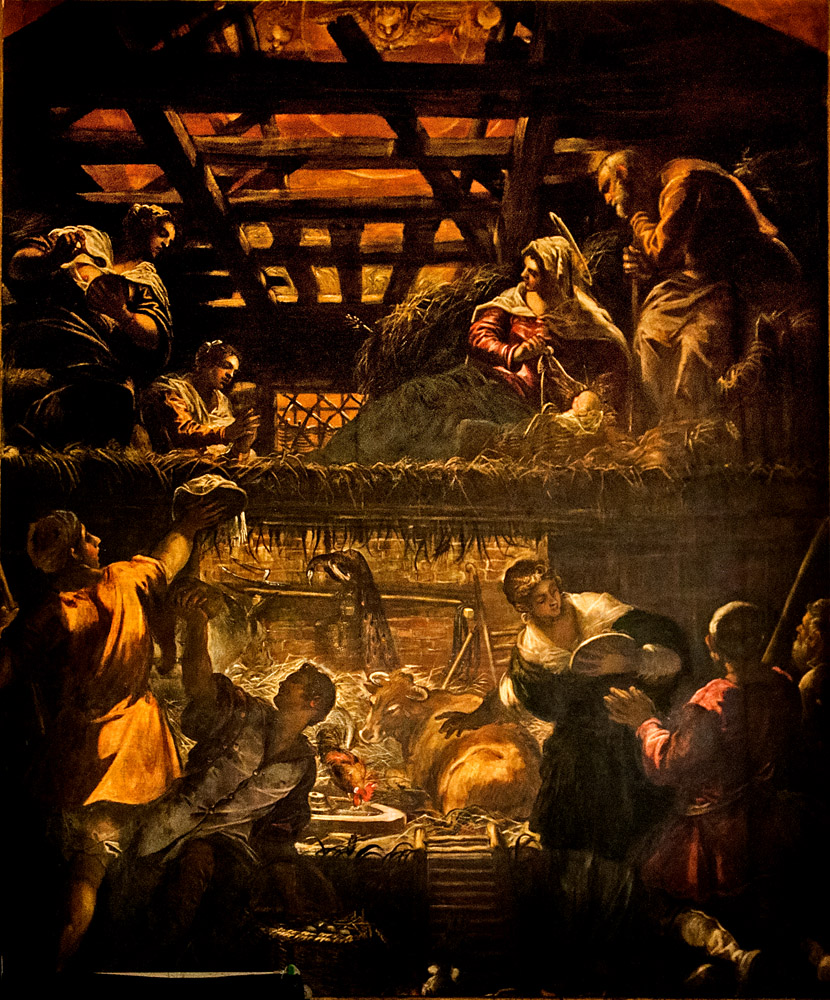
Adoration of the Shepards
If you then look to the painting off to the right, you’ll see the Adoration of the Shephards. It’s one of the most celebrated paintings in the room.
It’s another dark scene. It’s a fantastical shelter or manger, with an open roof that lets in a warm glow. It makes everything seem heated up.
The holy family is upstairs. On the lower level of the painting in the right hand corner is the main subject — the shepards themselves.
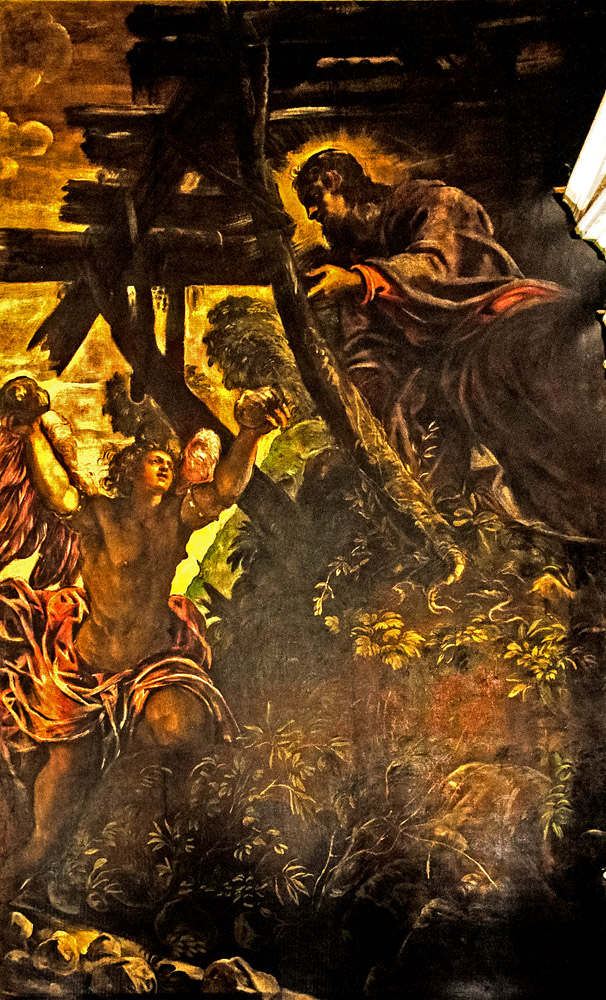
Temptation of Christ
This painting is to the right of the door leading to the Albergo. It’s an imaginative scene.
Christ is perched on a hill underneath a makeshift shelter. You see him turning his attention down to an angel, who holds two stones. This was one of the three temptations offered to Christ from Lucifer.
The angel is quite beautiful. In fact, it’s how Lucifer once appeared before his fall, when he was the angel of light.
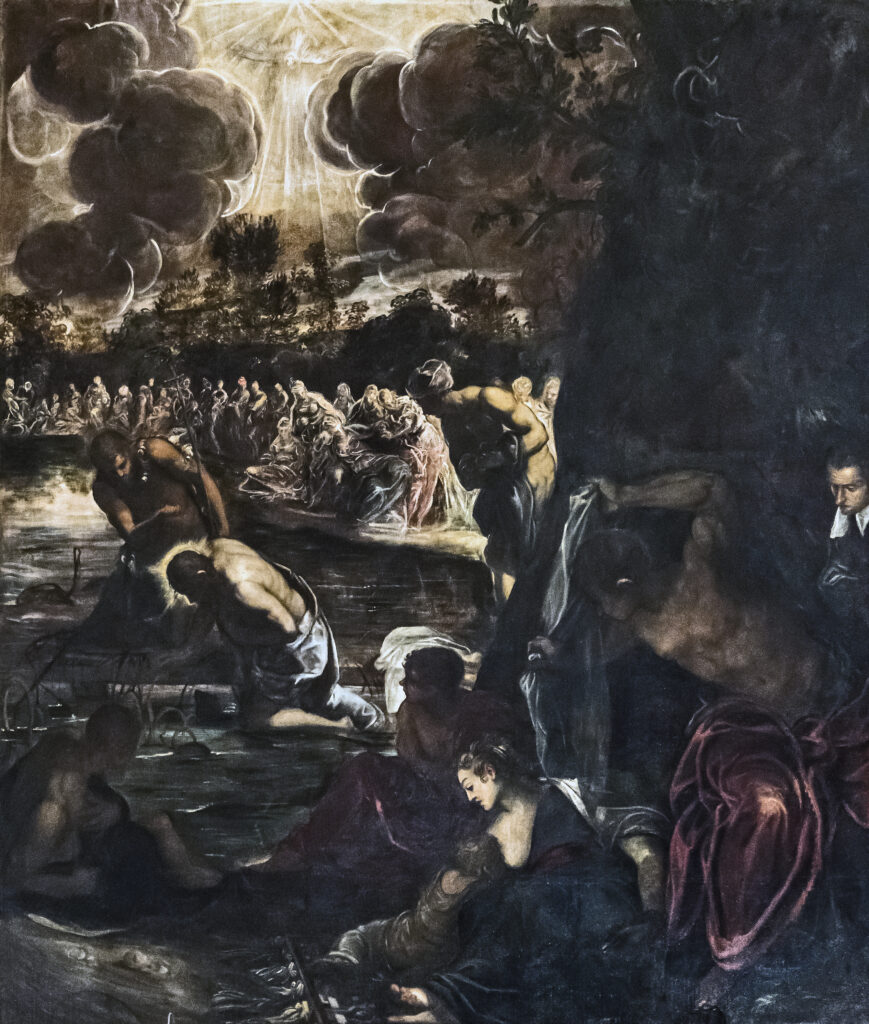
The Baptism of Christ
This is another dark, almost grimy scene. Yet the composition is lovely and emphasizes Christ’s humanity.
There’s a group of figures in the immediate foreground. One catches your eye immediately. He’s wearing a red drape over his legs. His torso twists in an impossible position trying to get a glimpse of what is going on.
The main subject, the baptism, is pushed off center to the left and is a very unconventional scene. Christ appears to be kneeling in a swamp (rather than standing). He’s being comforted by John the Baptist.
It’s an odd baptism image though. Christ almost looks like he’s getting sick and John has a quizzical expression on his face.
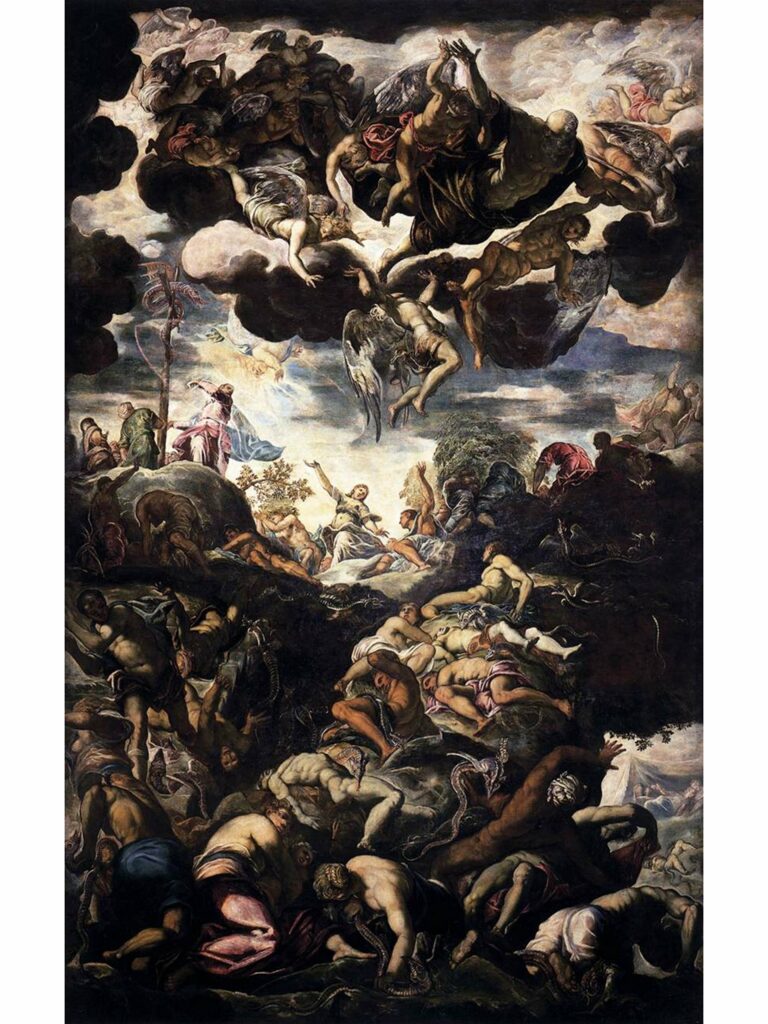
The Brazen Serpent
This story is about the Israelites grumbling to Moses. For their ingratitude, God sends a plague of venomous serpents.
They ask Moses to save them. The story goes that he lifted up a bronze statue of a serpent. Anyone who looked at it would be healed. This, of course, is another allusion to the Scuola’s mission of healing.
Tintoretto’s interpretation presents a mass of writhing dead bodies in the foreground. In the middle ground, the serpent isn’t bronze, but fully alive.
At the top is a muscular figure of God, who allows the healing. The members of the scuola likely saw themselves akin to Moses, healing their fellow countrymen. They even had their own “bronze serpent” enshrined within their church.
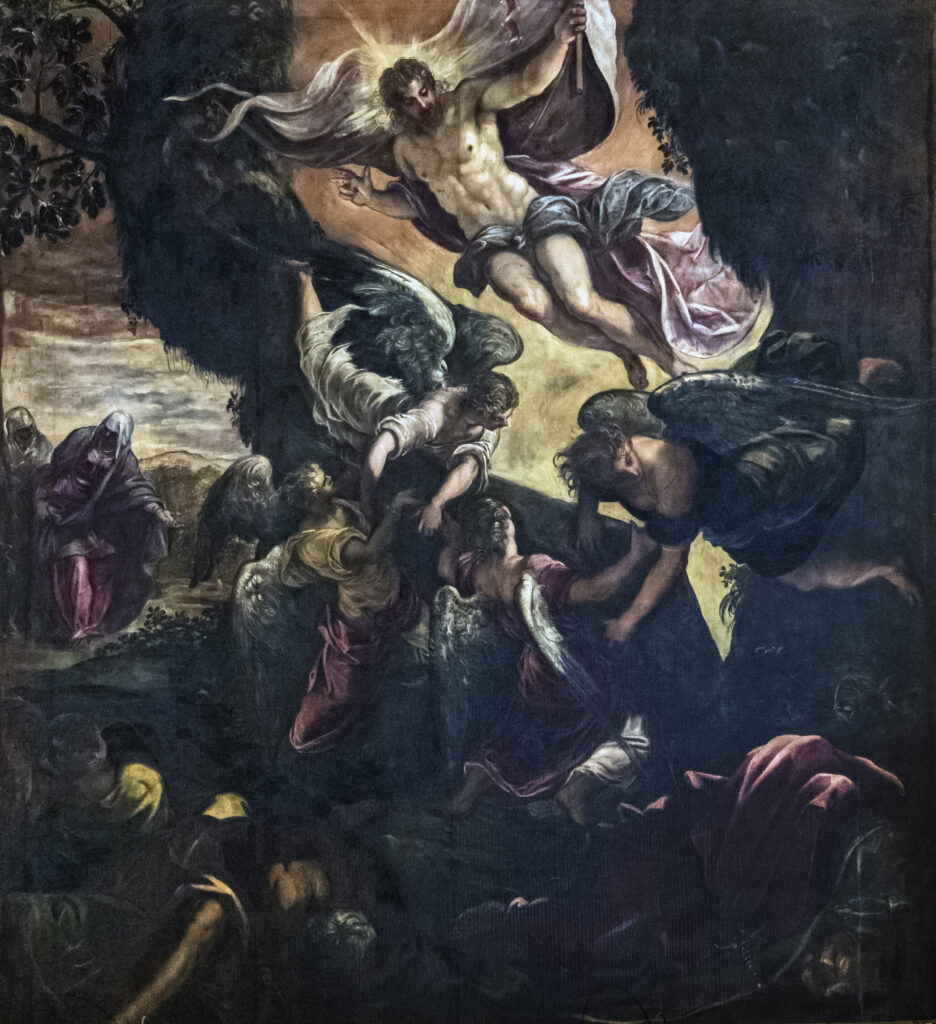
Resurrection of Christ
In this painting, Tintoretto goes rather Hollywood in his rendering of the resurrection.
The angels appear like a swat team as they draw a massive slab away from the tomb. Light blazes from the tomb.
Christ comes flying out of the tomb, the light radiating all around him with a halo on his head.
On the far left side are the two Marys (Mary Magdalene and the Virgin Mary). They are completely unaware of what is going on.
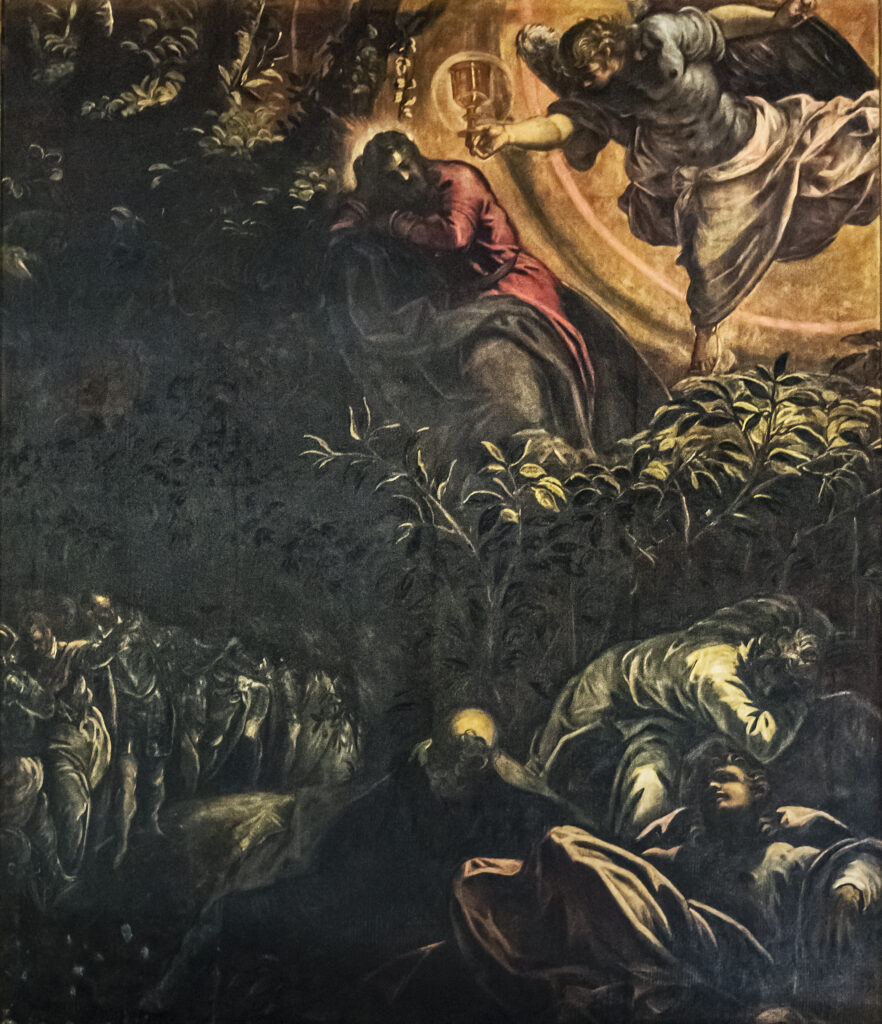
Agony in the Garden
Agony in the Garden captures a pivotal moment where Christ grapples with his impending sacrifice, with a mix of apprehension and unwavering resolve.
He’s shown turning from a comforting angel offering a chalice, as his gaze is fixed on the imminent ordeal. Beneath him, the apostles John and Peter slumber, oblivious to Christ’s inner turmoil.
This painting exemplifies Tintoretto’s signature style. The composition weaves together simultaneous scenes in a spatially distorted manner, evoking a dreamy ambiance. This approach make it seem like we’re peering into Christ’s internal reflections.
As usual, chiaroscuro heightens the drama. Light radiates from the angel’s chalice, cascading across the canvas, enveloping the sleeping apostles, and illuminating Christ’s vision. The contrast emphasizes the inevitability of the impending darkness.
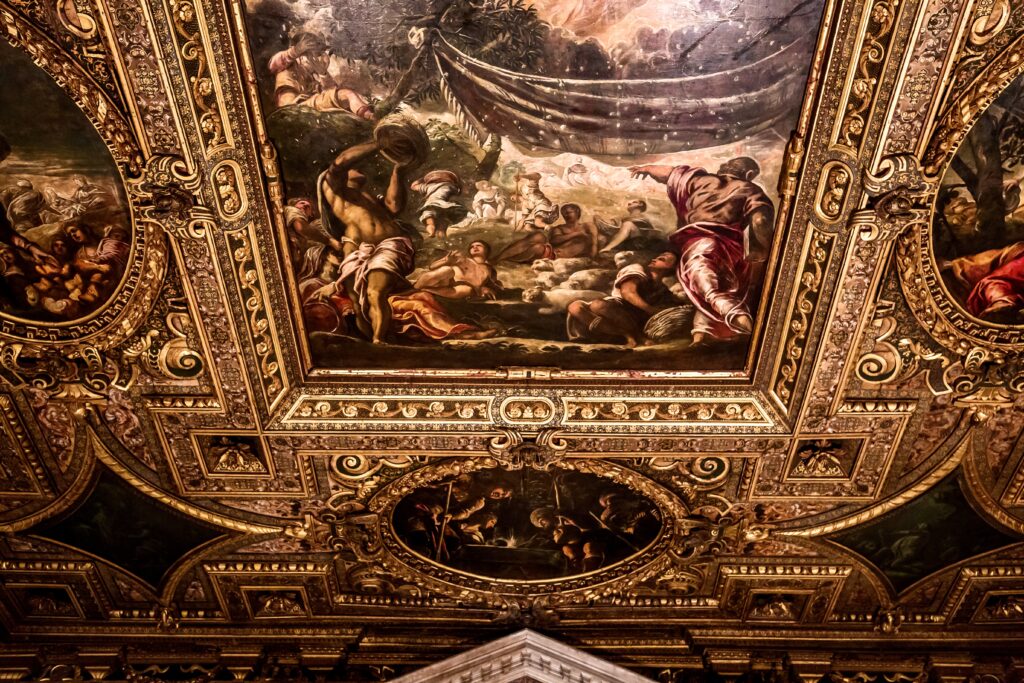
Gathering of the Manna
The Gathering of the Manna is one of the most celebrated paintings in the room. It was meant as a reminder of humanity’s dependence on divine providence and the certainty of its assistance.
It depicts the story of God’s miraculous provision for the Israelites during their desert journey. It shows the pivotal moment when the Israelites, hungry and wandering in the desert, are graced with manna.
Tintoretto meticulously adheres to the biblical account, capturing the manna’s showering down like snow under the cover of night. The nocturnal setting not only aligns with the biblical narrative but also amplifies the sense of divine mystery and providence.
The sky opens and a flowing God appears lit from above. Manna that appear like hosts fall from heaven. A white net across the painting captures it. In the bottom left corner, Moses (dressed in pink) gestures to the food.
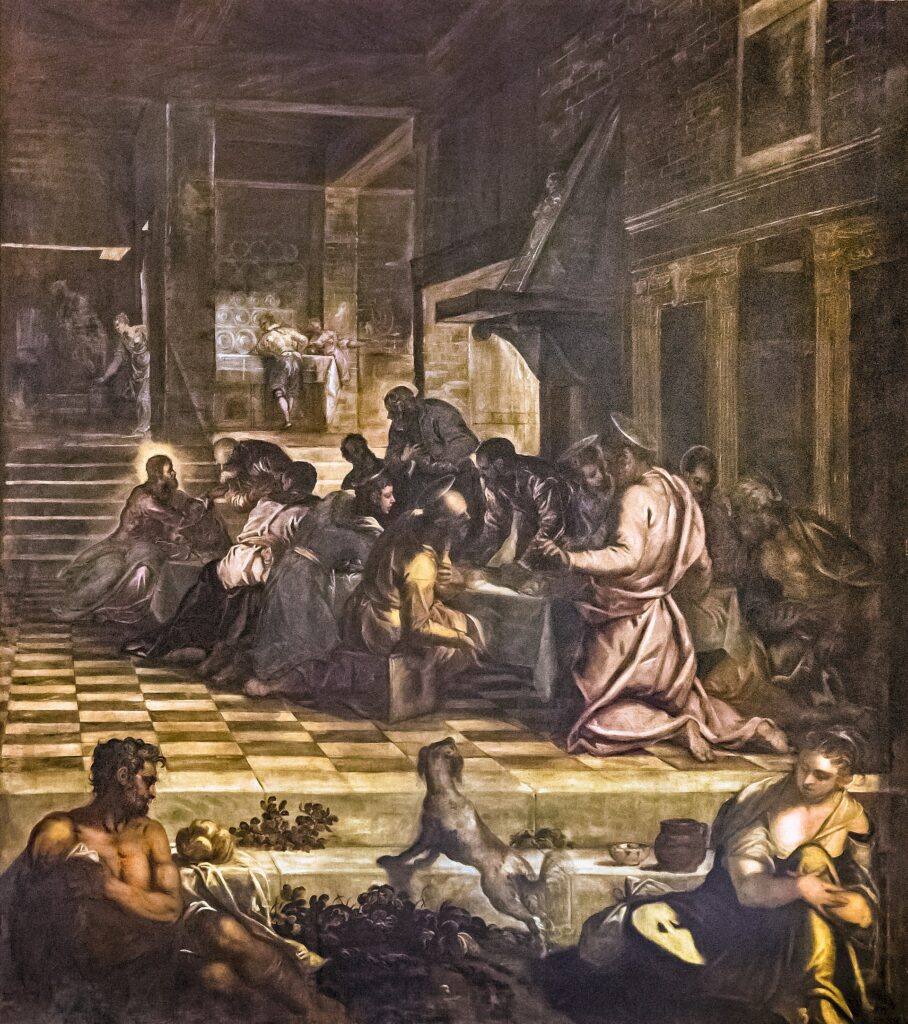
The Last Supper
This is kind of a tough painting to see. It’s dark and the room is dark, so give your eyes a bit of time to adjust.
The painting represents the institution of the eucharist, so follows the scuola’s theme of food and nourishment. But in true Tintoretto fashion, the composition is organized quite differently to most Last Supper paintings.
This is a strong diagonal composition. Christ is placed deep in space at the far end of the table. You can tell it’s him by the halo of light.
The supper is held in what looks like a tavern. There are only 11 apostles. Judas has apparently already left to set things in motion for his betrayal.
READ: 20 Last Supper Paintings from the Renaissance
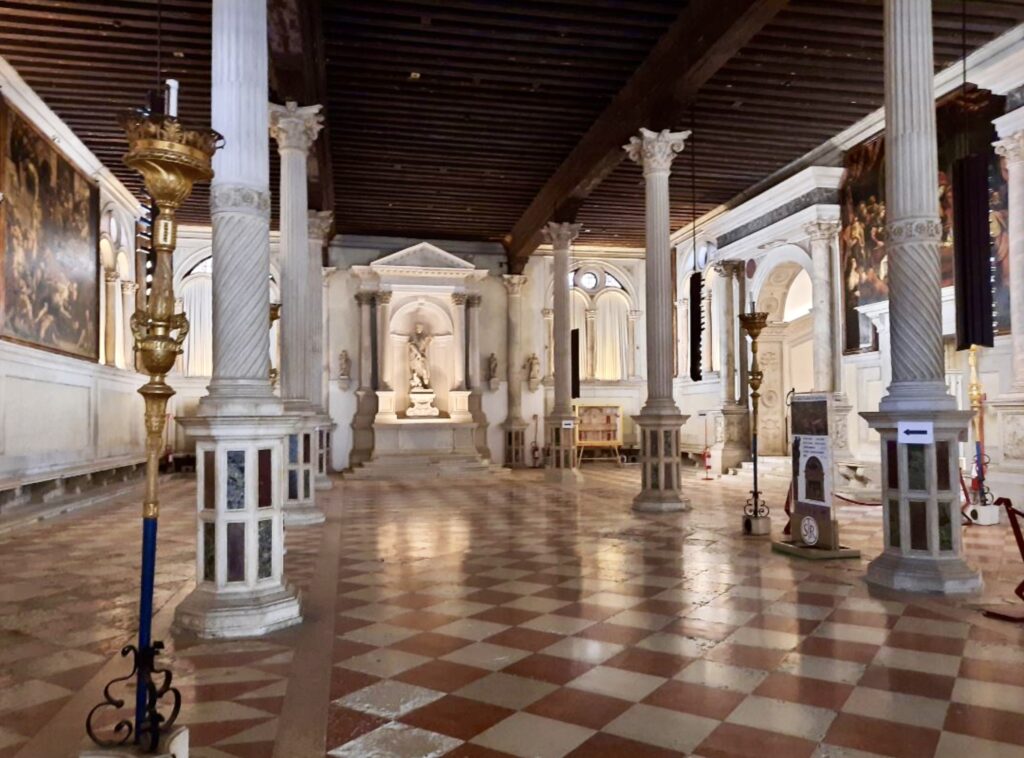
3. Tintoretto Paintings On The Ground Floor Hall
In 1581, Tintoretto had completed nearly all the paintings for the Chapter Hall. This left only the ground floor, the Sala Terrana, which needed substantial attention.
The ground floor is divided into a nave and two side aisles separated by rows of columns. There’s a large altar with a monumental sculpture of St. Roch.
Between 1581 and 1587, Tintoretto focused on this task and created 8 paintings illustrating moments from the early life of Christ and the Virgin Mary.
Most of the paintings on this floor are placed between the large double arched windows that run the length of the hall. I’ll cover a couple of the most famous ones.
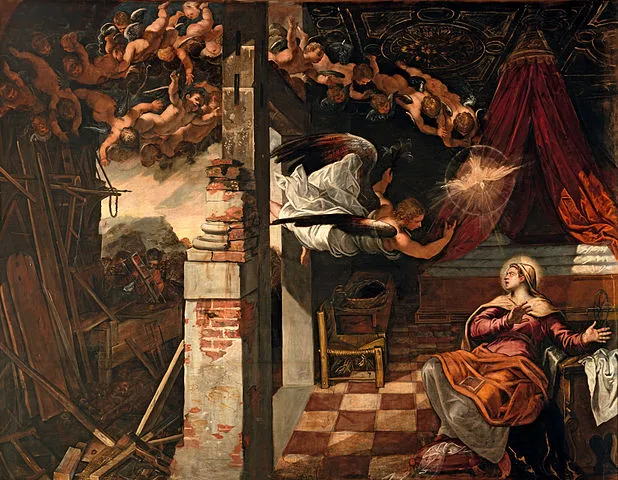
Annunciation
Tintoretto’s Annunciation takes center stage on this floor. The annunciation is the moment when the angel Gabriel arrives to tell Mary that she will soon conceive Christ.
Most artists depict the annunciation as a serene instance of gentle astonishment and peacefulness. Tintoretto, as was his habit, deviated from the norm. Instead, in his portrayal, the annunciation transforms into a scene of remarkable tumult and frenzy.
Tintoretto’s rendition is a whirlwind of motion. The angel Gabriel bursts in horizontally, igniting a sensation of urgency. Cherubic putti dive bomb through an open window from above. This dynamic composition almost evokes a sense of invasion.
Interestingly, the Virgin’s expression reflects more than just surprise. There’s a touch of shock and even apprehension. It’s as though the profound encounter has left an indelible mark on her.
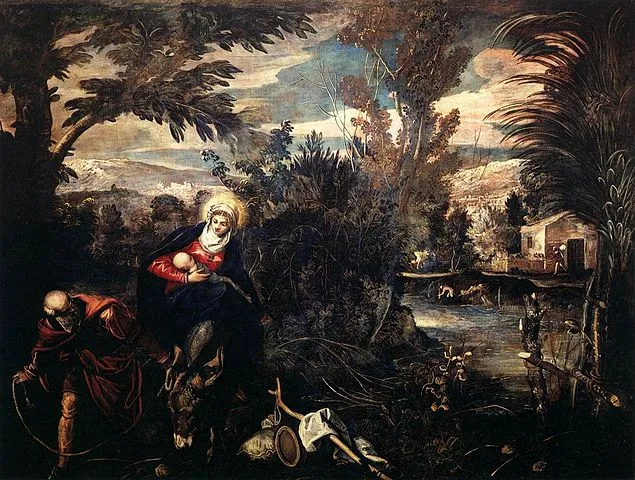
Flight Into Egypt
Tintoretto’s Flight into Egypt portrays the holy family’s journey as they flee from Herod’s brutal massacre of the innocents.
Egypt is depicted as a sort of renewed Garden of Eden, providing a tranquil haven where the holy family seeks refuge.
Tintoretto renders the landscape in meticulous fashion, particularly the lush array of trees and bushes that border the river.
Amid the scene’s jubilance, subtle reminders of Christ’s impending sacrifice emerge — notably the cross protruding from the ground on the right side and the palm tree rising above it.
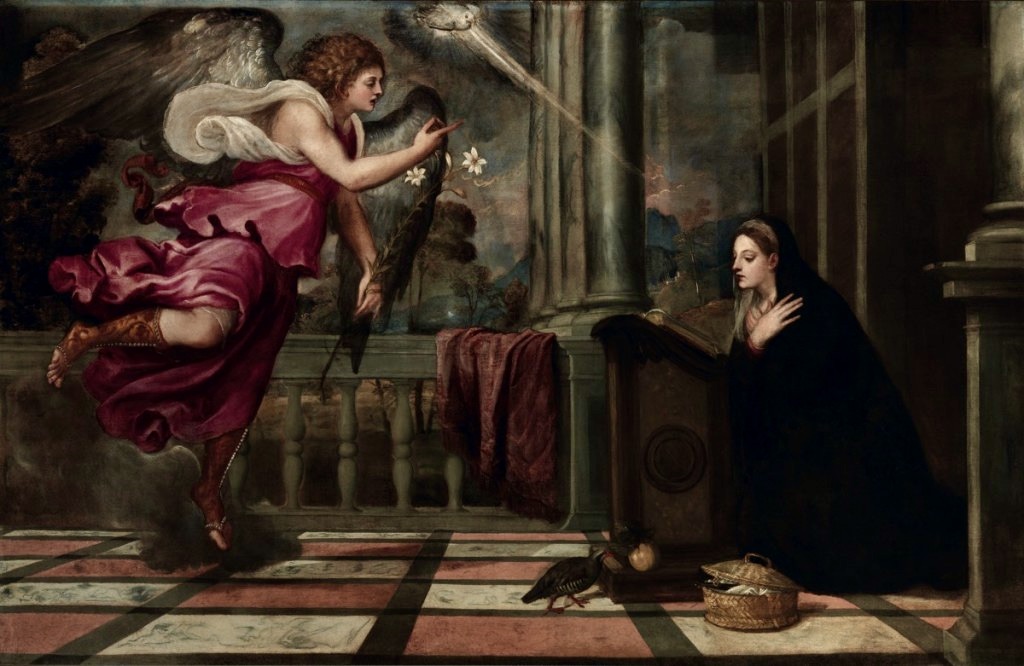
4. Titian’s Annunciation
In 1555, Titian’s Annunciation was bequeathed to the scuola.
It’s found above one of the landing arches of the grand staircase, enclosed within an intricately carved and gilded frame bearing the donor’s arms.
The composition is beautifully simple, with the Virgin and the angel as the central figures. They stand against an architectural backdrop of a marble balustrade and columns, which opens up to a landscape of trees and rocks.
There was once skepticism about Titian’s authorship of the painting. Today, however, the attribution to him is unanimously accepted, dating the painting back to around 1535.
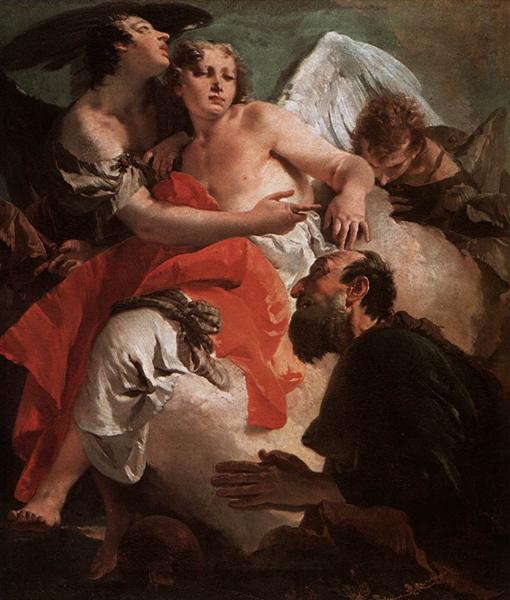
5. Tiepolo Paintings
There are also two remarkable works by Giambattista Tiepolo on the left wall of the staircase leading up to the Treasury.
These masterpieces were created during the artist’s remarkably creative period in the early 1730s. They portray two pivotal episodes from the story of Abraham.
In the first painting, Abraham and the Angels, you see the moment when angels, disguised as travelers, are welcomed by Abraham. After accepting his hospitality, the angels reveal their divine nature and share the news that his wife Sara will become pregnant even though she’s quite old.
The second artwork, Agar and Ishmael, depicts a poignant scene where an angel, sent by God, rescues Ishmael from imminent danger.
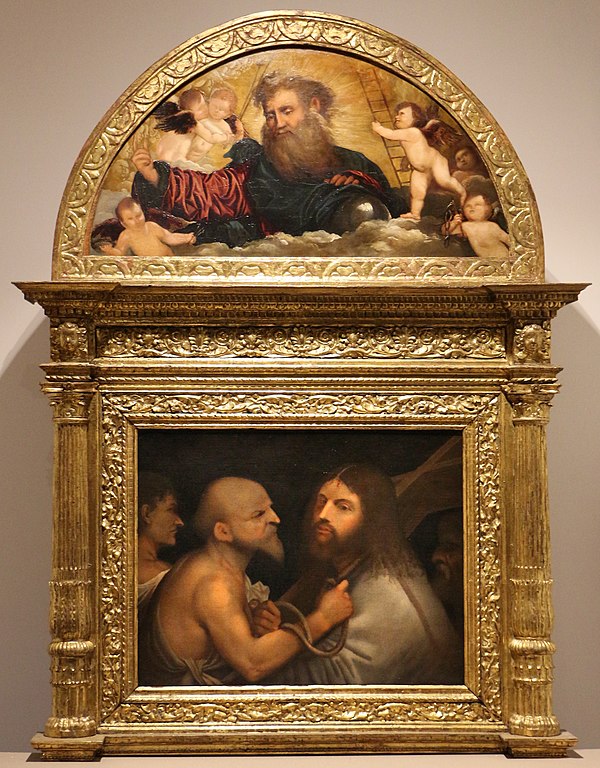
6. Giorgione’s Christ Carrying the Cross
Giorgione was an enigmatic Venetian Renaissance artist. He only had a brief 15 year career before dying prematurely from the plague at just 37.
As a result, there are very few of his extant works. Of those that exist, some art historians debate whether they should be attributed to Titian, who was also a student of Giovanni Bellini at the time.
Art historian Giorgio Vasari initially attributed Christ Carrying the Cross to Giorgione and then corrected himself and said it was a Titian. In the 19th century, it was reattributed to Giorgione. But the debate rages on.
What’s not up for debate is that it’s one of the most significant artworks in the scuola’s collection.
Like Giorgione’s late realist works, Christ’s face bears a serene yet intense expression, capturing a moment of respite before the impending ordeal. This brief pause is abruptly interrupted as the executioner tightens the noose around Christ’s neck, plunging him back into his harrowing ordeal.
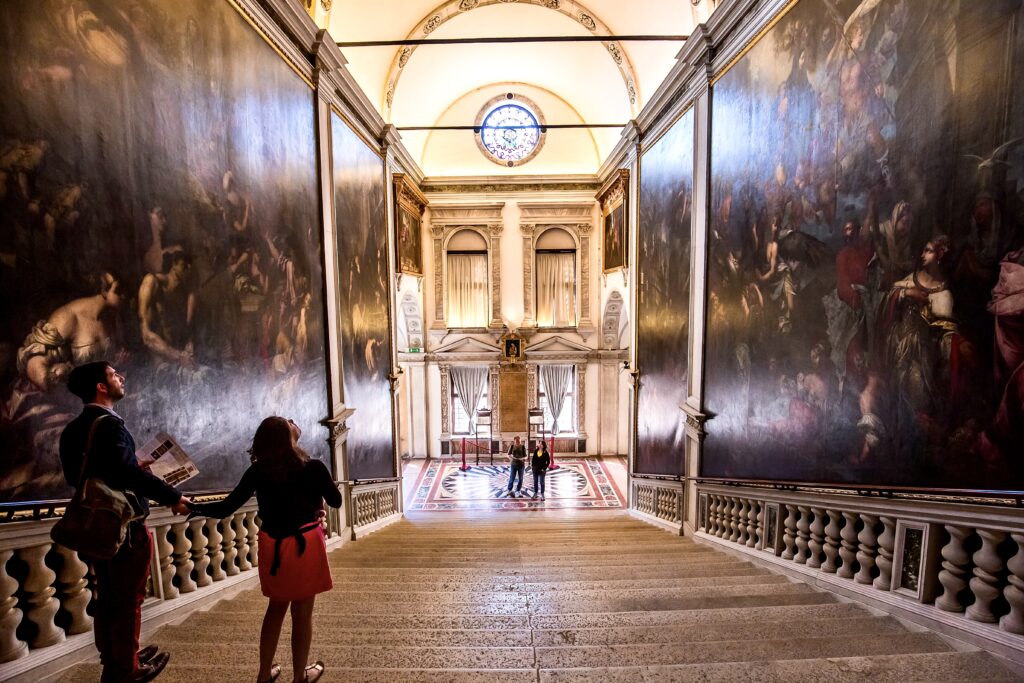
Practical Guide & Tips For Visiting The Scuola Grande di Rocco
Address: Campo San Polo, 3054, a, 30125 Venezia VE
Hours: Open daily 9:30 am to 5:30 pm.
Ticket Price: 10 euros. You won’t need to make a reservation in advance.
Dress Code:
Wear clothing that covers your shoulders and knees. This means avoiding sleeveless tops, short shorts, and miniskirts. If it’s hot and you’re wearing a sleeveless top or dress, bring a shawl to cover up.
But I have to say, this dress code is pretty informal and not enforced (at least when I was there).
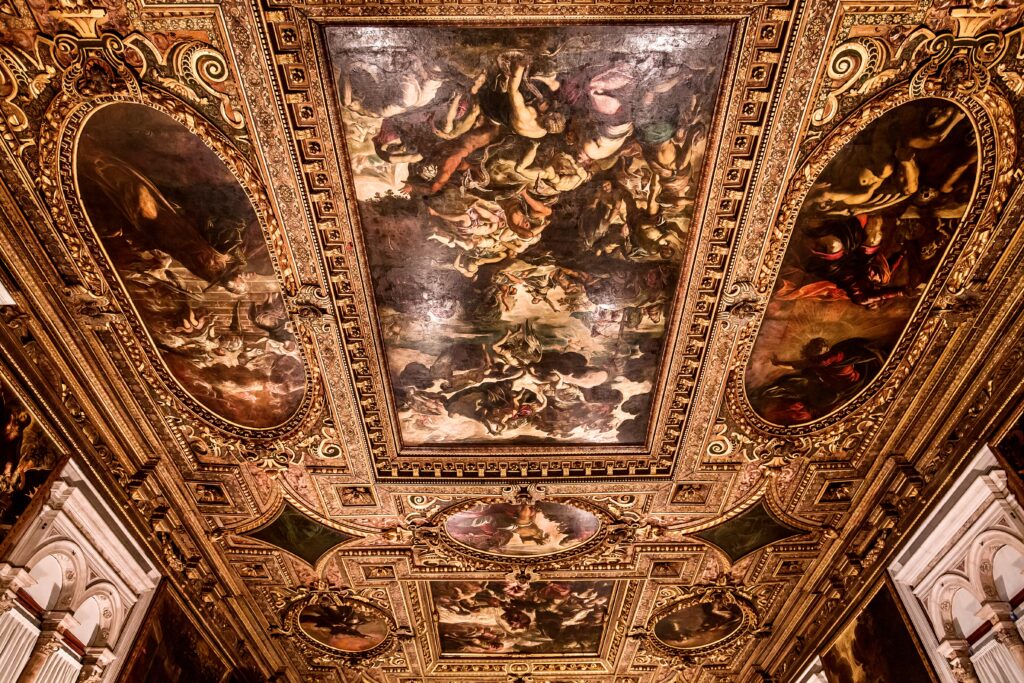
Pro Tips:
The Scuola Grande di San Rocco occasionally hosts concerts and cultural events in the evenings. It also sits behind another beautiful church that you should visit, the Basilica of Sant Maria Glorioso dei Frari.
I hope you’ve enjoyed my guide to the Scuola Grande di Rocco. You may enjoy these other Venice travel guides and resources.
- One day in Venice itinerary
- 2 days in Venice itinerary
- Guide to the Accademia Gallery
- Guide to the Doge’s Palace
- Guide to St. Mark’s Basilica
- Top Attractions on the Grand Canal
- Guide to the Peggy Guggenheim Collection
- Venice art bucket list
- How many days to spend in Venice?
- 30+ tips for visiting Venice
If you need a guide to the Scuola Grande di Rocco, pin it for later.

